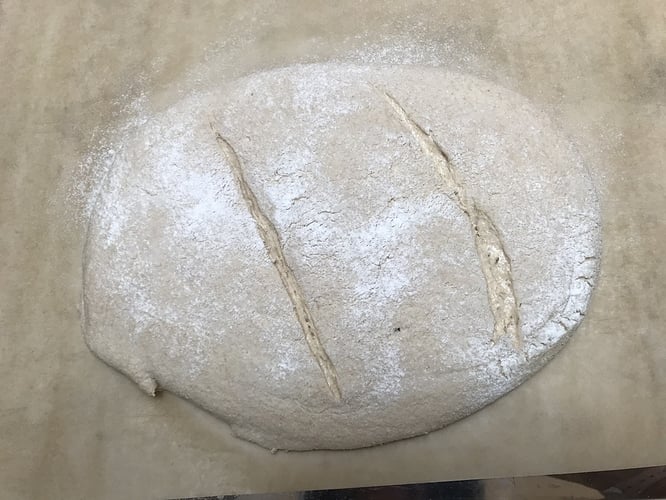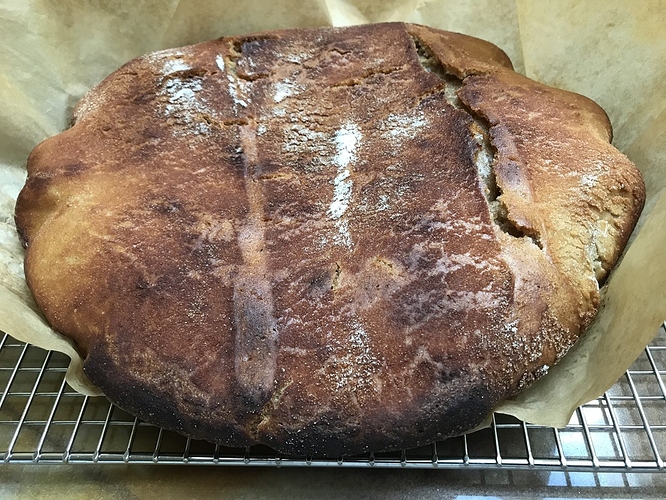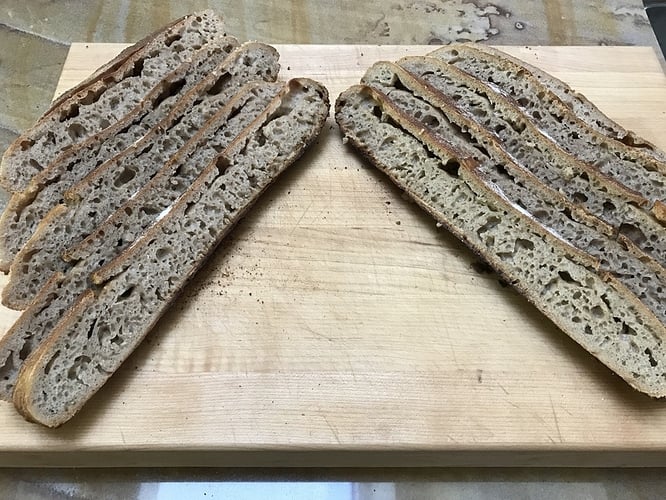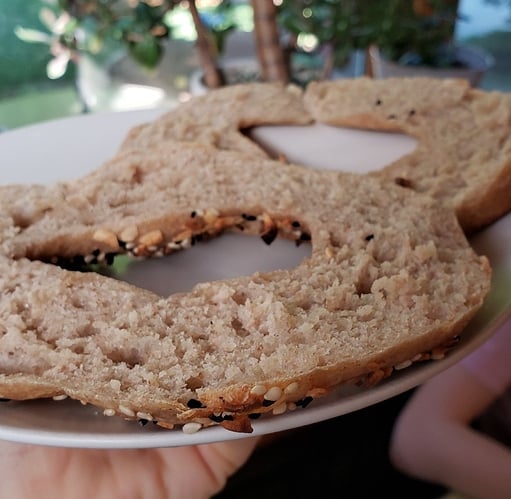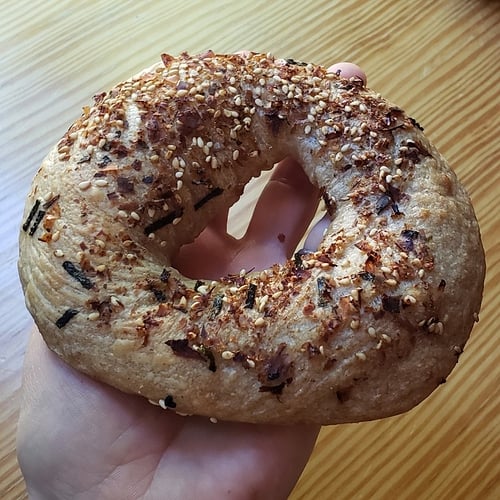Thank you Thumbpicker. Makes sense.
I usually go straight from the refrigerator to the oven, unless I think it is underproofed, then I’ll take it out for a few hours.
Loaf #2, after more than 72 hours in the fridge, is even better looking than the first one, which I proofed according to the directions. I pulled it out at 3:30 this afternoon, looking sad and saggy. I, once again thought, “oh well, let’s give it a go” and put it the proofing basket, and popped it in the oven at 6:30. The stuff is indestructible. Believe me, I’ve been trying for over a year and can’t destroy a loaf

Thanks for the information. My second only no knead sourdough loaf (half white half whole wheat) was in the fridge for 24 hours and it was delicious and more sour than my first loaf of no knead white bread. Now to experiment with other flours.
I am sure there are many different reasons for doing a ‘long’ fermentation. I have used it in 3 instances. 1. The longer the dough ferments (without over-fermenting), the sourer the bread will be. In general, it takes at least 10 hours of bulk fermentation to taste a noticeable souring taste. However, if the dough is refrigerated, it takes more than 10 hours to get the same sour taste as 10 hours without refrigeration. Therefore, if one wants to refrigerated the dough and still have a significant sour tasting bread, fermentation must be longer.
2. To allow one to sleep all night. Putting the dough in the frig overnight (as long as the starter inoculation is low) will allow more hours of sleep. I gave up on this since, even with an 8% inoculation, the most sleep I could get was ~ 6-7 hours. However, this was without refrigeration. I probably could have gotten more time if I had refrigerated the dough. I simply didn’t want to have to wait for the dough to reach room temp and continue fermenting as that would have made the process an 18-24 hour process instead of only 12-15.
3. To allow one to make the dough, go to work, and come home to shape the loaf. Since I am retired, I have not tried this and don’t know how time-consuming this actually is (once one gets home from work).
This was great thank you very much. I used to get “mouse holes” regularly when I first started baking bread years ago and never understood why. Moving to a retarted bulk fermentation is simply something I did because I was following one of your sourdough recipes. I will have to experiment a little on my own with retarding the final proof since it may come in handy on those days when life doesn’t want to follow my bread baking schedule. Thank you also very much for the videos!
Here is my extended cold final proof experiment…
25% Kamut
85% hydration
Just a small spoonful of rye starter
2% salt
13 hour 20 minute initial proof (low starter and cool kitchen temperatures)
42 hour 30 minute final proof in 38F refrigerator
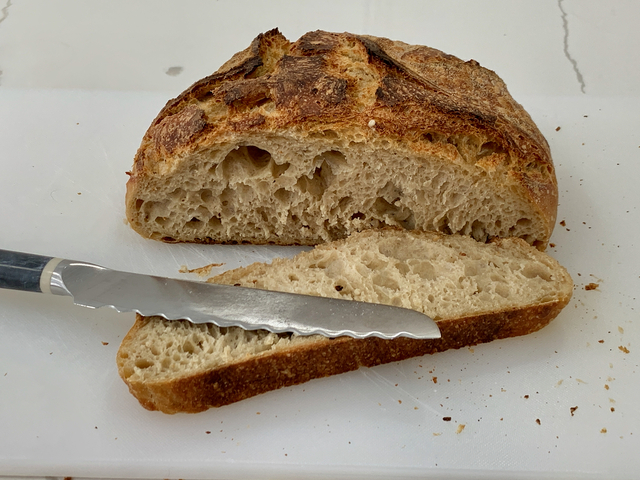
@SilverTwist All valid points! Regarding getting a good night sleep, lately I’ve been learning how long my dough needs to bulk ferment at 55-60F. Since December’s panettone project, when my husband wired up an electric cooler/warmer box for me, I’ve occasionally played with that cooler-but-not-dormancy-inducing temperature.
@HealthHermit I’m glad the post was helpful. It’s interesting how the refrigerator can paralyze a bulk fermentation. I suspect because fermentation curve is so steep, with activity really low at the beginning and then exponentially increasing, the moment on that curve when you retard the dough can make a big difference. The goal being that with observation and experience, we can have more and more of a sense of what to expect when we open our fridge and check on the dough. Though surprises keep it exciting too 
@SingKevin That looks awesome and like it held up no problem to the long bulk and final proof. How’s the flavor?
On the dormancy temperature aspect I think that’s why so many people have different results during their retards. I recently proved some dough at room temperature for an hour and 15 minutes and the dough had risen a reasonable amount for that length of time. I couldn’t bake until midday the next day so I tried to factor in some extra rise in the fridge and that didn’t really happen even after 15 hours!
So the take away from that is (imo) when it comes to a cold fridge you may need to pre-prove the dough almost completely! I believe the flavour still greatly benefits from the retard even at a cold temperature.
[EDIT] I measured my fridge’s temperature and it’s 2.5C (36.5F)
@Fermentada The bread was surprisingly mild for such a long proof. I had expected it to be very sour but it wasn’t at all. Just a very nice sourdough taste. BTW, I love using a wine fridge to ferment and more often final proof dough at 55F. Very helpful when timing would not otherwise work.
That mild sour was my experience with the extra-long cold final proof too. I get a stronger sour with a room temperature ferment of an enriched dough that moves slowly due to ingredients.
It’s kind of fun to open up my cooler and see what state my dough is in. Here’s what I found this morning…a little farther along than I would have liked, but not a problem.
I’ve been making no-knead sourdough bread for years. I have a proofing bucket, but usually use a 1 gallon glass canister for refrigerator proofing, rather than putting the formed loaves in the baskets (they require my refrigerator to not be full). I’ve had great success with forming my loaves straight from the fridge and putting in the oven once heated. I use the clay bake molds, removing the lids half-way thru the bake. AND I often run out of time for long ferment after my 4 folds every 30 minutes, so it mainly proofs in the fridge. Still if I run out of time for baking, I’ve baked 4 days later, and the loaves are great! If the dough is really active and I find it’s popped the lid, wanting to overflow, I refold it and return it to the canister and refrigerator. Never had any bad bread. We’ve started liking the taste of a longer refrigerator proof. Sourdough is healthier for us and is the best! Best pizza dough, waffles (freeze for toaster waffles), crepes, crackers, aebleskivers …
Sounds like a great process.
Melissa, I landed on this article because I am trying to get information as to whether or not cold proofing will help a dough maintain its shape. If you remember I am the one that “insists” on using Vitamix ground Emmer Farro for her bread.  I would like to try the ‘Artisan Sourdough No-Knead Bread’ on Breadtopia, which is 50/50 Whole Wheat. I am thinking of trying this recipe using Emmer because this bypasses the hardships I encounter in shaping an Emmer loaf. On top of that, I was contemplating on baking this in a Le Creuset Dutch Oven instead of my oval baker. My oval baker does not have a good seal and I would like to see if my crust will improve if I used a dutch oven instead. I think that this no-knead dough will pancake without the support of a wall. So, I thought I would cold proof the dough instead of doing the final proof in room temp. What do you think of this idea? I do worry that the fact that Emmer is low gluten might contribute to pancaking, cold proof or not. Thanks in advance for your help.
I would like to try the ‘Artisan Sourdough No-Knead Bread’ on Breadtopia, which is 50/50 Whole Wheat. I am thinking of trying this recipe using Emmer because this bypasses the hardships I encounter in shaping an Emmer loaf. On top of that, I was contemplating on baking this in a Le Creuset Dutch Oven instead of my oval baker. My oval baker does not have a good seal and I would like to see if my crust will improve if I used a dutch oven instead. I think that this no-knead dough will pancake without the support of a wall. So, I thought I would cold proof the dough instead of doing the final proof in room temp. What do you think of this idea? I do worry that the fact that Emmer is low gluten might contribute to pancaking, cold proof or not. Thanks in advance for your help.
Yes, I remember – you made the beautiful loaves here
I think cold proofing can help with shape retention, and there’s no downside unless you don’t have the refrigerator space or you’re trying to prevent any sourness in the final bread – I suspect Emmer takes a long time to get sour anyway.
This is the recipe you’re referring to, right?
For a little more assurance on not-pancaking, you might drop the water to 418g (80%). Emmer is thirsty, but not a gluten powerhouse like hard red wheat flours. Making the dough a touch dryer may help when it’s time for shaping.
Otherwise, I wouldn’t worry too much about not having side-wall support. Half the flour in the recipe is bread flour, which will offer a fair amount of structure. And there are some stretch and folds in the process if I recall correctly.
Ok Melissa be prepared to laugh. Thank you for your advice on decreasing hydration. Can not imagine what it would have been like if I did not. Ok so bulk fermentation started around 3:30p. 6 hours later, dough had already more than doubled and i’m like 4 more hours? So I’m getting antsy. So at 7 hours I did a coil fold. But I thought the dough was still too weak. So I abandon the concept of no-knead, let it rest 1 hour and did another coil fold. Still no good. Rest another hour and on coil fold #3, I’m like I’m in big doodoo. The dough has crossed over and what gluten was there looks like it is gone. So I decide to just pour the dough into the proofing basket and stuck it into the refrigerator. 13 hours later, it pancaked upon transfer onto a parchment sheet and it “rose” sideways during baking. Tasted good anyway tho. I’ve done an experiment with Emmer at 66% hydration before and every hour that passes, the dough get “soupier”/wetter. Of course at the very start there is no gluten. After 2 hours it is better but still breaks. After 4 hours they seem to stay together but the dough flows like syrup and stays that way hours after that. I think i would have been fine if after 7 hours and the coil fold I just poured the dough into the proofing basket. THEN used a clay baker with walls to hold it up. So I think the conclusion is, if I want to use Emmer I have to use the clay baker even if it does not result in a nice crust.
If the volume more than doubled (however long that took), then the bulk proof was done (or maybe even a bit overdone). Ignore recipe times and pay attention to the dough.
Here’s my polemic:
You also say you used home ground emmer, but I can’t tell from your words whether that’s all you used or if you mixed it with something else - like the 50% high gluten bread flour in the recipe that Melissa mentioned. If it’s 50/50 with bread flour, then probably the pancaking you had was due to either or both of too high hydration and over-proofing. If you are trying to make a loaf with 100% whole emmer, then I’ll just say that based on my experience with emmer, I would proof and bake in a bread pan.
I agree with what @homebreadbaker wrote – doubling the dough probably got you into over-fermented territory, especially if you were de-gassing the dough a bit with each stretch and fold.
You crumb looks nice though. I’d call the bread an emmer ciabatta and feel victorious 
I had a flattened experience this morning too, though I don’t know how to rebrand this end result.
I accidentally overhydrated my bagel dough. I tried to correct the dough-feel after I realized I must’ve had something stuck under my scale while pouring water, but I definitely didn’t add enough flour. I even contemplated making a braided bread out of the super extensible and floppy bagel tubes. But they were too wet for that even! (These six “bagels” are proofing as a boule still in my refrigerator.)
@Bentio check out the furikake bagel topping that your crackers inspired!
Very nice Melissa. How did you like the furikake flavours in a bagel?
Deliciously awesome. This should be a thing. I will go make it a thing.
(I bet it’s already a thing.)

